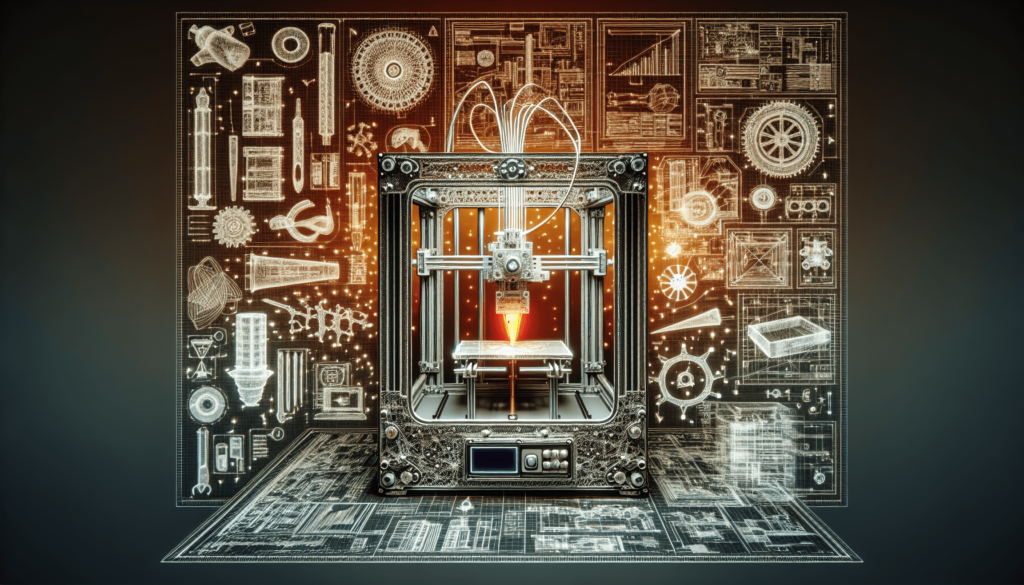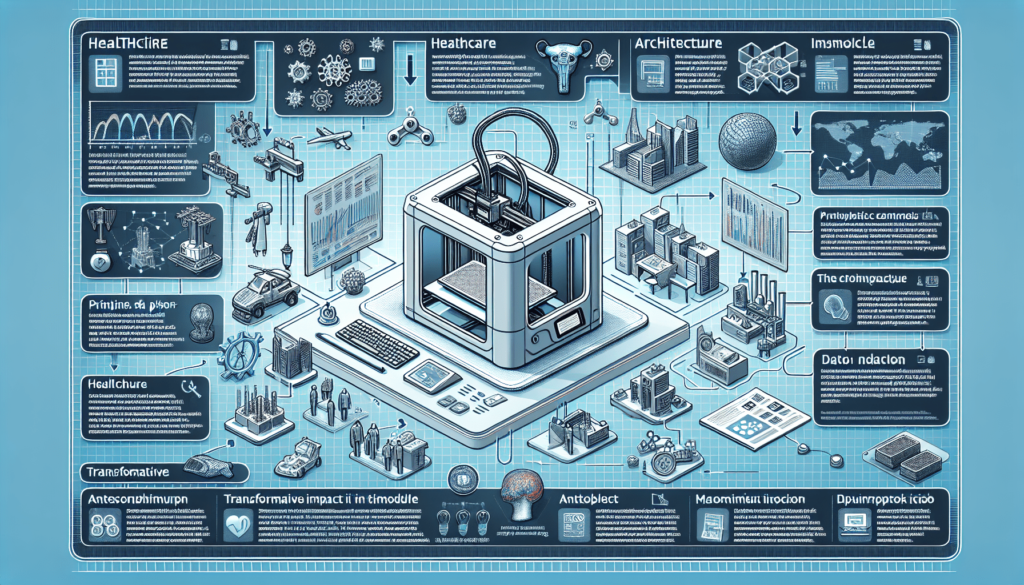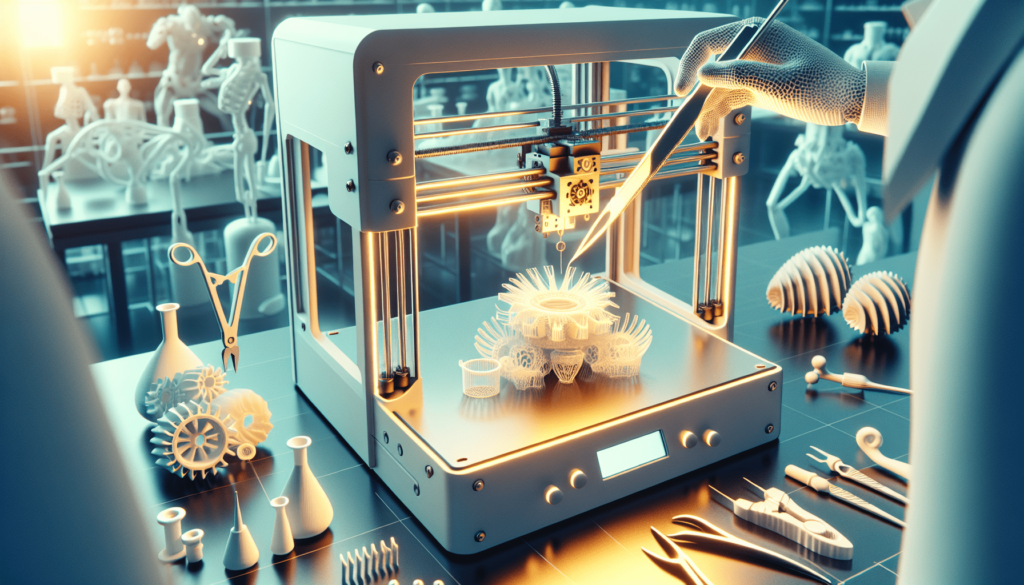Imagine being able to create physical objects from digital designs. That’s the magic of 3D printing technology! Whether you’re an engineer, an artist, or just someone curious about this cutting-edge innovation, there are a few key things you need to know. From the basics of how it works to the incredible possibilities it offers, this article will give you a friendly introduction to the world of 3D printing technology. So buckle up and get ready to explore this exciting realm where imagination meets reality!

Types of 3D Printing Technology
Fused Deposition Modeling (FDM)
Fused Deposition Modeling (FDM) is one of the most commonly used 3D printing technologies. It involves the use of a thermoplastic filament which is heated and extruded layer by layer to create the desired object. FDM is known for its versatility and affordability, making it suitable for a wide range of applications.
Stereolithography (SLA)
Stereolithography (SLA) is an additive manufacturing technology that uses a liquid resin that is cured using ultraviolet (UV) light. This process involves the use of a vat of liquid resin, a laser, and a build platform. SLA is known for its ability to produce highly detailed and accurate prints, making it popular in industries such as jewelry, dentistry, and engineering.
Selective Laser Sintering (SLS)
Selective Laser Sintering (SLS) is a 3D printing technology that uses a high-powered laser to selectively fuse powdered materials together to create a solid object. SLS is commonly used with powdered plastics, such as nylon, and is especially popular for creating functional prototypes and end-use parts.
Digital Light Processing (DLP)
Digital Light Processing (DLP) is a 3D printing technology that uses a digital micromirror device (DMD) to selectively project UV light onto a vat of liquid resin, curing it layer by layer. DLP is known for its high printing speed and ability to produce smooth and highly detailed prints. It is often used in industries such as dentistry, jewelry, and automotive.
Selective Laser Melting (SLM)
Selective Laser Melting (SLM) is an advanced 3D printing technology that uses a high-powered laser to selectively melt and fuse metallic powders together. SLM is highly precise and produces strong and durable metal parts. It is commonly used in industries such as aerospace, automotive, and medical for creating complex and customized metal components.
Applications of 3D Printing
Rapid prototyping
One of the key applications of 3D printing is rapid prototyping. 3D printing allows designers and engineers to quickly create physical prototypes of their designs, enabling them to test and iterate their ideas more efficiently. This saves time and cost compared to traditional prototyping methods, which often require extensive tooling and manufacturing processes.
Product development
3D printing is also widely used in product development. It enables companies to speed up the design process, reduce the need for tooling and molds, and produce functional prototypes and small-scale production runs with ease. This flexibility allows for faster product iteration and brings products to market more quickly.
Medical applications
The medical field has greatly benefited from the advancements in 3D printing technology. It has revolutionized the production of customized prosthetics, implants, and surgical guides. 3D printing allows for patient-specific designs, improving the fit and function of medical devices. It has also played a crucial role in tissue engineering, enabling the creation of complex 3D structures for regenerative medicine and drug testing.
Art and design
Artists and designers have embraced 3D printing as a medium for expressing their creativity. It allows for the production of intricate and unique sculptures, jewelry, and fashion pieces. With 3D printing, artists are no longer limited by traditional manufacturing techniques, and they can explore complex geometries and innovative designs.
Education
3D printing has become an essential tool in education, from elementary schools to universities. It provides students with hands-on experience in design and engineering principles. Students can bring their ideas to life by creating physical objects, fostering creativity and problem-solving skills. Furthermore, 3D printing enables educators to demonstrate abstract concepts in a tangible and visually engaging way.

Materials Used in 3D Printing
Plastics
Plastics are the most commonly used materials in 3D printing. They come in a wide range of formulations, each with its own unique properties and applications. Common types of 3D printing plastics include PLA (polylactic acid), ABS (acrylonitrile butadiene styrene), and PETG (polyethylene terephthalate glycol).
Metals
Metal 3D printing has gained significant popularity in recent years. Stainless steel, aluminum, titanium, and nickel alloys are commonly used in metal additive manufacturing. Metal 3D printing offers the ability to create complex geometries and produce functional metal parts with excellent mechanical properties.
Ceramics
Ceramic 3D printing opens up new possibilities in the fields of architecture, art, and biomedical engineering. Materials such as porcelain, earthenware, and bone china can be 3D printed, allowing for intricate and detailed ceramic objects. This technology enables the creation of unique pottery, customized dental implants, and even bone scaffolds for tissue engineering.
Biocompatible materials
Biocompatible materials are essential in medical applications of 3D printing. They allow the production of implants, prosthetics, and surgical instruments that are compatible with the human body. Biocompatible materials include various medical-grade plastics, metals such as titanium, and even biocompatible ceramics.
Composite materials
Composite materials combine two or more different materials to create unique properties. In 3D printing, composite filaments can be used to enhance the strength, flexibility, or conductivity of printed objects. Carbon fiber, fiberglass, and metal-filled filaments are examples of composite materials used in 3D printing.
Advantages of 3D Printing Technology
Customization
One of the key advantages of 3D printing is its ability to create customized and personalized objects. Each print can be tailored to the specific requirements of the user, whether it’s a custom-fit medical implant or a one-of-a-kind piece of jewelry. This level of customization is not possible with traditional manufacturing methods.
Cost-effectiveness
3D printing offers cost savings in various aspects of the manufacturing process. It eliminates the need for costly molds and tooling, reducing upfront expenses. Additionally, 3D printing allows for on-demand production, reducing inventory costs and the risk of overproduction.
Quick turnaround time
3D printing enables rapid production of objects. Designs can be turned into physical objects within hours or days, depending on the complexity and size of the print. This quick turnaround time is beneficial for time-sensitive projects, product development, and emergency medical applications.
Reduced waste
Traditional manufacturing processes often generate a significant amount of waste material. 3D printing, on the other hand, is an additive process that only uses the necessary amount of material. This reduces waste and contributes to a more sustainable manufacturing approach.
Complexity in design
3D printing allows for the creation of highly complex and intricate designs that would be difficult or even impossible to produce with traditional methods. The layer-by-layer additive manufacturing process gives designers the freedom to explore complex geometries, organic shapes, and internal structures.

Limitations of 3D Printing Technology
High equipment cost
Although the cost of 3D printers has decreased in recent years, high-quality industrial-grade 3D printers can still be expensive. In addition to the initial investment, ongoing maintenance costs and the cost of materials can be significant.
Limited material choices
While the range of materials used in 3D printing continues to expand, it still lags behind the wide variety of materials available in traditional manufacturing processes. Certain specialized materials, such as high-performance metals and ceramics, may have limited availability or be cost-prohibitive for 3D printing.
Slow printing speed
3D printing can be a time-consuming process, especially when printing large and complex objects or when using high-resolution settings. The layer-by-layer additive nature of 3D printing means that it may take hours or even days to complete a print, depending on the size and complexity of the object.
Post-processing requirements
After 3D printing, many objects require additional post-processing to achieve the desired finish and functionality. This can involve tasks such as removing support structures, sanding, polishing, or applying additional coatings. Post-processing can add time and labor costs to the overall manufacturing process.
Quality issues
3D printing technology has made significant advancements in terms of print quality, but it still faces certain limitations. Surface finish, dimensional accuracy, and material properties may not always meet the standards required for certain applications. Quality control and optimization of the printing process are ongoing challenges in the industry.
Future Potential of 3D Printing
Medical advancements
3D printing holds great promise for the medical field. It has the potential to revolutionize areas such as organ transplantation, customized medical devices, and drug delivery systems. Researchers are exploring the use of 3D bioprinting to create functional human tissues and organs, which could significantly impact healthcare in the future.
Sustainable manufacturing
As sustainability becomes a growing concern, 3D printing offers a more eco-friendly alternative to traditional manufacturing methods. With its ability to reduce waste, use fewer materials, and produce on-demand, 3D printing has the potential to contribute to a more sustainable manufacturing industry.
Space exploration
The aerospace industry has already embraced 3D printing for its ability to produce complex and lightweight structures. As space exploration advances, 3D printing could play a crucial role in manufacturing parts, tools, and even habitats in space, reducing the need for costly and logistically challenging launches from Earth.
Customized consumer products
The rise of e-commerce and consumer demand for personalized products has created opportunities for 3D printing. In the future, consumers may be able to customize and print their own products at home, avoiding long shipping times and reducing the carbon footprint associated with traditional retail distribution.
Architecture and construction
3D printing has the potential to revolutionize the construction industry. Large-scale 3D printers can be used to create entire buildings quickly and cost-effectively. This technology could enable the production of affordable housing, reduce construction waste, and create innovative architectural designs.

3D Printing Industry Trends
Manufacturing partnerships
Partnerships between 3D printing companies and traditional manufacturers are becoming more common. This collaboration allows for the integration of 3D printing technology into existing manufacturing processes and enables the production of hybrid components that combine the benefits of additive and subtractive manufacturing.
Advancements in 3D printing software
Software plays a crucial role in 3D printing, from design to print preparation and control. Advancements in 3D printing software are simplifying the design process, optimizing print parameters, and enhancing the user experience. Improved software capabilities contribute to better print quality and efficiency.
Increased affordability of 3D printers
The cost of 3D printers has been steadily decreasing over the years, making them more accessible to individuals and small businesses. Affordable desktop 3D printers are widely available, allowing hobbyists, educators, and entrepreneurs to explore the possibilities of 3D printing without breaking the bank.
Growing demand for on-demand production
On-demand production is gaining popularity as consumers expect faster delivery times and customized products. 3D printing allows for the production of small quantities and even single items without the need for extensive tooling and inventory. This shift towards on-demand manufacturing is reshaping the supply chain and logistics industry.
Integration with Internet of Things (IoT)
The Internet of Things (IoT) refers to the network of interconnected devices that can communicate and share data. 3D printing can be integrated with IoT technologies to enable remote monitoring, predictive maintenance, and real-time quality control in the manufacturing process. This integration enhances productivity and efficiency in 3D printing operations.
Challenges and Ethical Considerations
Intellectual property concerns
As 3D printing makes it easier to replicate and reproduce objects, there are concerns about intellectual property rights. Protecting copyrighted designs, patented inventions, and trademarks becomes more challenging in a world where 3D printing technology is readily available to the masses.
Regulatory compliance
The regulatory landscape surrounding 3D printing is still developing. Issues such as product safety, liability, and certification standards need to be addressed to ensure that 3D printed products meet established industry regulations and quality standards.
Security risks
As with any digital technology, 3D printing faces security risks. There is the potential for unauthorized production of counterfeit products, illicit firearms manufacturing, and the unauthorized reproduction of sensitive or copyrighted objects. Ensuring secure and responsible use of 3D printing technology is a crucial consideration.
Environmental impact
While 3D printing has the potential to reduce waste compared to traditional manufacturing methods, it still has an environmental impact. The consumption of energy and raw materials, as well as the disposal of unused and failed prints, must be carefully managed to minimize the ecological footprint of 3D printing.
Social and economic implications
The widespread adoption of 3D printing could have significant social and economic implications. It may disrupt traditional manufacturing industries, leading to job displacements. The accessibility and affordability of 3D printing could also widen existing social inequalities, as not everyone has equal access to the technology and the skills required to utilize it.
3D Printing Workflow
Designing the 3D model
Before 3D printing can take place, a 3D model of the object needs to be created using computer-aided design (CAD) software. The design can be created from scratch or obtained from a 3D scan.
Slicing the model into layers
The 3D model is sliced into thin layers using specialized software. Each layer is then converted into a set of instructions that the 3D printer can understand.
Preparing the printer
The 3D printer needs to be prepared before printing. This involves loading the appropriate material into the printer (such as plastic filament or metal powder) and ensuring that the printer is calibrated and ready to begin the print job.
Printing the object
Once the printer is prepared, the 3D model is sent to the printer, which starts the additive manufacturing process. The printer follows the instructions generated by the slicing software, depositing the material layer by layer to build up the object.
Post-processing and finishing
After the object is printed, it may require post-processing to achieve the desired finish. This can involve removing support structures, sanding, polishing, or applying coatings or paint. Post-processing is an important step in ensuring the final quality and appearance of the printed object.
Key Players in the 3D Printing Industry
Stratasys
Stratasys is one of the leading companies in the 3D printing industry. They offer a wide range of professional-grade 3D printers and technologies, catering to various industries and applications. Stratasys is known for its innovation and commitment to advancing the adoption of 3D printing technology.
3D Systems
3D Systems is another major player in the 3D printing industry. They provide a comprehensive portfolio of 3D printing solutions, including hardware, software, and materials. 3D Systems is focused on driving innovation and expanding the possibilities of 3D printing across industries.
EOS
EOS is a pioneer and global leader in industrial 3D printing. They specialize in metal and polymer 3D printing technologies, offering high-performance and scalable solutions for additive manufacturing. EOS has a strong focus on quality, precision, and reliability in their products.
Formlabs
Formlabs is a company known for its desktop 3D printers and resin-based 3D printing technology. They have made 3D printing more accessible to individuals, small businesses, and educational institutions. Formlabs is dedicated to delivering high-quality and user-friendly 3D printing solutions.
HP Inc.
HP Inc. is known for its expertise in printing technology and has ventured into the 3D printing market. They offer industrial-grade 3D printers that deliver high-quality prints at scale. HP Inc. integrates their knowledge of traditional printing with 3D printing technology, bringing innovation and efficiency to the industry.

